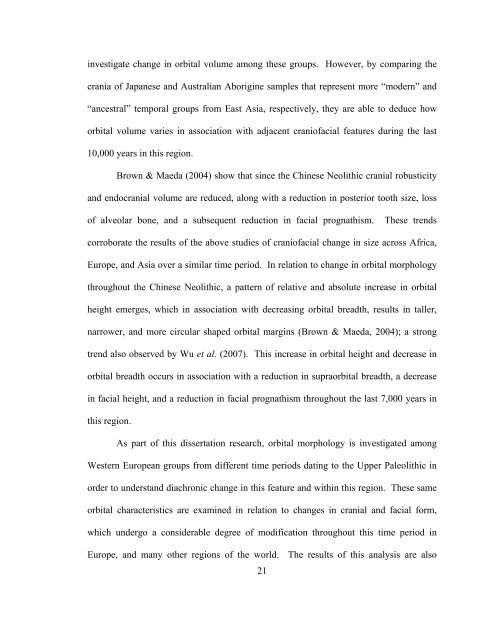modern variation and evolutionary change in the hominin eye orbit
modern variation and evolutionary change in the hominin eye orbit
modern variation and evolutionary change in the hominin eye orbit
You also want an ePaper? Increase the reach of your titles
YUMPU automatically turns print PDFs into web optimized ePapers that Google loves.
<strong>in</strong>vestigate <strong>change</strong> <strong>in</strong> <strong>orbit</strong>al volume among <strong>the</strong>se groups. However, by compar<strong>in</strong>g <strong>the</strong>crania of Japanese <strong>and</strong> Australian Aborig<strong>in</strong>e samples that represent more “<strong>modern</strong>” <strong>and</strong>“ancestral” temporal groups from East Asia, respectively, <strong>the</strong>y are able to deduce how<strong>orbit</strong>al volume varies <strong>in</strong> association with adjacent craniofacial features dur<strong>in</strong>g <strong>the</strong> last10,000 years <strong>in</strong> this region.Brown & Maeda (2004) show that s<strong>in</strong>ce <strong>the</strong> Ch<strong>in</strong>ese Neolithic cranial robusticity<strong>and</strong> endocranial volume are reduced, along with a reduction <strong>in</strong> posterior tooth size, lossof alveolar bone, <strong>and</strong> a subsequent reduction <strong>in</strong> facial prognathism. These trendscorroborate <strong>the</strong> results of <strong>the</strong> above studies of craniofacial <strong>change</strong> <strong>in</strong> size across Africa,Europe, <strong>and</strong> Asia over a similar time period. In relation to <strong>change</strong> <strong>in</strong> <strong>orbit</strong>al morphologythroughout <strong>the</strong> Ch<strong>in</strong>ese Neolithic, a pattern of relative <strong>and</strong> absolute <strong>in</strong>crease <strong>in</strong> <strong>orbit</strong>alheight emerges, which <strong>in</strong> association with decreas<strong>in</strong>g <strong>orbit</strong>al breadth, results <strong>in</strong> taller,narrower, <strong>and</strong> more circular shaped <strong>orbit</strong>al marg<strong>in</strong>s (Brown & Maeda, 2004); a strongtrend also observed by Wu et al. (2007). This <strong>in</strong>crease <strong>in</strong> <strong>orbit</strong>al height <strong>and</strong> decrease <strong>in</strong><strong>orbit</strong>al breadth occurs <strong>in</strong> association with a reduction <strong>in</strong> supra<strong>orbit</strong>al breadth, a decrease<strong>in</strong> facial height, <strong>and</strong> a reduction <strong>in</strong> facial prognathism throughout <strong>the</strong> last 7,000 years <strong>in</strong>this region.As part of this dissertation research, <strong>orbit</strong>al morphology is <strong>in</strong>vestigated amongWestern European groups from different time periods dat<strong>in</strong>g to <strong>the</strong> Upper Paleolithic <strong>in</strong>order to underst<strong>and</strong> diachronic <strong>change</strong> <strong>in</strong> this feature <strong>and</strong> with<strong>in</strong> this region. These same<strong>orbit</strong>al characteristics are exam<strong>in</strong>ed <strong>in</strong> relation to <strong>change</strong>s <strong>in</strong> cranial <strong>and</strong> facial form,which undergo a considerable degree of modification throughout this time period <strong>in</strong>Europe, <strong>and</strong> many o<strong>the</strong>r regions of <strong>the</strong> world. The results of this analysis are also21
















